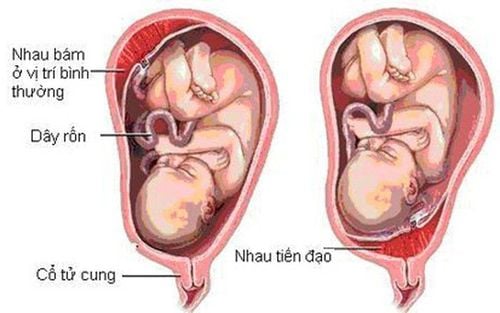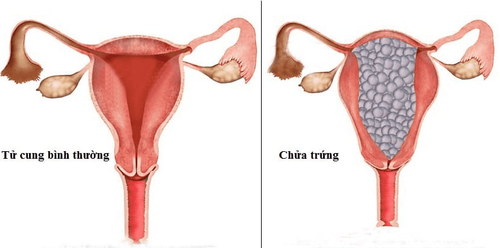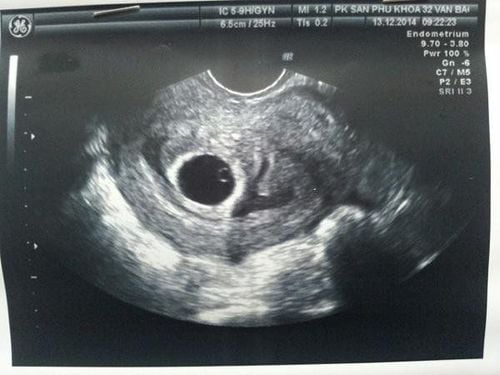This is an automatically translated article.
There are many causes of bleeding in the second half of pregnancy, in some cases only medical treatment is needed, but there are cases where urgent emergency care is needed to save the mother and the fetus. Therefore, when there are any signs of bleeding in the second half of pregnancy, pregnant women must immediately go to a medical facility for timely intervention.1. Bleeding in the second half of pregnancy
Bleeding in the second half of pregnancy can have many causes. Mild vaginal bleeding can be caused by inflammation or exposure of the uterine gland, which can be treated medically. In some cases, heavy second-half bleeding may occur, usually due to placental anomalies. Two common causes are placenta previa and placenta previa. In addition, threatened uterine rupture, uterine rupture or preterm labor can also cause bleeding in the third trimester of pregnancy.1.1 Abortion of placenta Normally, placenta will stick to the uterine wall, placental abruption is a condition in which placenta detaches prematurely before delivery due to disease or trauma, this is a common cause of bleeding in the last month of pregnancy. .
Symptoms of placental abruption depend on the severity of the disease:
Mild form: the patient's general condition is normal, with little bleeding. On examination there may or may not be fetal distress. The disease is usually diagnosed only with an ultrasound. Moderate form: the patient has pre-eclampsia syndrome, the uterus is heavily contracted, the fetal heart rate may be fast or slow, the vaginal blood volume is moderate. The patient may have mild shock. Severe form: the patient is in severe pain, has severe preeclampsia, black vaginal bleeding, thin and does not clot. On examination, there is no fetal heart rate, uterine muscle tone is increased, the uterus is hard like wood, the cervix is hard, the amniotic fluid is distended, there may be blood in the amniotic fluid. The patient should be rapidly resuscitated against shock (fresh blood should be given) and cesarean section should be performed. Replenish circulating blood volume with fluids to prevent coagulopathy.
Trắc nghiệm: Bạn có hiểu đúng về dấu hiệu mang thai sớm?
Các dấu hiệu mang thai sớm không phải chỉ mỗi trễ kinh mà còn có rất nhiều dấu hiệu khác như xuất huyết âm đạo, ngực căng tức,… Điểm xem bạn biết được bao nhiêu dấu hiệu mang thai sớm thông qua bài trắc nghiệm này nhé!
1.2 Placenta previa Is a placenta attached to the lower part of the uterus that spreads to or covers the opening in the cervix. As a result, the placenta will completely or partially block the way out of the fetus during labor. Placenta previa is one of the common causes of bleeding in the last 3 months of pregnancy. The patient has symptoms of sudden bleeding, without abdominal pain, vaginal blood both bright red and clotted, bleeding conjunctivitis. abrupt end as well as in appearance. The interval between bleeding episodes is shortened, the amount of blood that flows back is more. Patients who lose a lot of blood can go into shock, which can be life-threatening. On examination, the fetal position is high or abnormal, the fetal heart rate is normal or the fetus is impaired if the mother is in shock.

Before labor: If the pregnancy is more than 36 weeks and placenta previa is central, elective caesarean section should be performed. If the pregnancy is still preterm, the bleeding is small, or the bleeding has stopped, treatment should be waited for the larger fetus. If the patient bleeds heavily, cesarean section immediately regardless of gestational age. When in labor: If the placenta is central or semi-central, the cesarean section must be performed immediately in combination with fluid resuscitation and blood transfusion. If the placenta is low, clinging to the edge, bleeding a lot, cesarean section; If bleeding is less, amniocentesis, amniotic membrane tearing and monitoring for vaginal delivery. 1.3 Threat of uterine rupture The mother has a lot of pain due to fast and strong uterine contractions. When examining, the Bandl ring is pulled up, the uterus is shaped like a gourd, the fetal heart rate is fast, slow or irregular. Vaginal examination shows abnormal fetal position, high or unreached position.
The patient will be treated with vasoconstrictor drugs, intravenous fluids, finding and treating according to the cause of the threatened uterine rupture. If it is the cause of difficult delivery, emergency cesarean section through the abdomen.
1.4 Uterine rupture Uterine rupture can cause bleeding in the last month of pregnancy. Before uterine rupture, the woman has signs of threatened uterine rupture, except in the case of old surgical scars in the uterus. Pregnant women are in severe pain, after a sudden sharp pain, the pain is gone and maybe shock. When the uterus ruptures, the uterine contractions of the mother no longer exist, the pulse is fast, the blood pressure decreases, the limbs are cold, sweating, ... When examining the abdomen, it is distended, painful, palpating the fetal part just below the skin. abdomen, the abdomen is distorted and there are no signs of threat of rupture, the fetal heart is lost, the vaginal examination cannot confirm the position of the fetus.
This is a life-threatening condition, the patient needs to be resuscitated against shock, raised blood pressure, blood transfusion and immediately transferred to the emergency operating room, treated uterine tear (conservative, total hysterectomy or hysterectomy) sold in full).
1.5 Threat of preterm birth Bleeding in last month of pregnancy can be a sign of labor. Before or right at the start of labor, the vagina will release some bloody mucus called pink vaginal mucus. If it happens around 3 weeks of due date, this is a normal sign. If it occurs earlier, it could be a sign of premature birth. Some other signs of preterm labor are increased vaginal discharge, a feeling of increased pressure in the pelvis, lower abdominal pain, dull back pain, stomach cramps, possibly with diarrhea, and other symptoms. uterine contractions or uterine contractions, mild cramping, amniotic fluid breaks a lot or leaks slowly. Thus, bleeding in the second half of pregnancy can be a sign of dangerous obstetric complications, threatening the health of mother and fetus. To ensure safety, when there are signs of bleeding in the second half of pregnancy, women must immediately go to medical facilities for timely examination and intervention.

Pregnant women will be consulted and checked for health under the close supervision of experienced and specialized Obstetricians, helping mothers have more knowledge to protect their health during pregnancy as well as reduce reduce complications for mother and child.
Please dial HOTLINE for more information or register for an appointment HERE. Download MyVinmec app to make appointments faster and to manage your bookings easily.













